My legs and lungs ached and burned as I tried and failed, once again, to jump across a long puddle of murky water onto some spongy undergrowth characteristic of the paramo, a ecological zone consisting of small shrubs and grasses usually found at high altitudes. My feet land a matter of inches from “clear” ground; this permits some fresh water to permeate into my already wet boots; my calves, although some-what soothed from the momentary absence of effort, receive the wrath of a spiny bush whose personal space I’ve just infringed upon. It is not really raining; just cold clouds blowing into me, getting everything wet, similar to a cold steam-room. At this particular moment I had lost a sense of the events that had happened before beginning our climb up Cerro Chirripo. I became disconnected from my expectations and prejudices about what remained ahead of me for the remainder of the trip. The beautiful hike up to this miserable ridge the previous day, the purpose for our climb, the thought of dinner, and the anticipation of reaching the summit disappeared, leaving me in a cold, cloudy, painful world stumbling toward a distant shelter. |
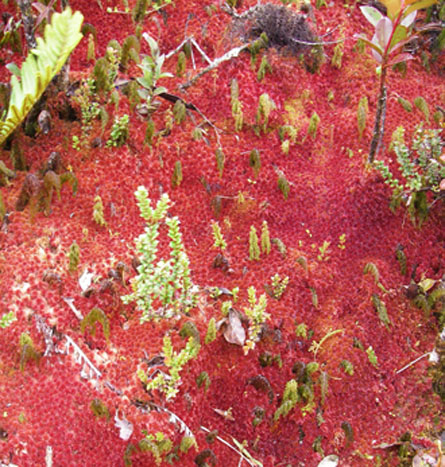 Red moss in the paramo |
Chirripo lies in the Cordillera Talamanca of southern Costa Rica. The Costa Rican government determined that these high mountains and diverse ecological zones and high mountains would complement the nation’s numerous other national parks. We chose to go here not only to view its stunning natural environment, but also because it happens to be the place in Costa Rica where you can deprive yourself of the most oxygen. At 12,500 ft, only the volcano Tajumulco in Guatemala is higher, of all the peaks in Central America. Furthermore, unlike most of the other high places in Costa Rica and Central America, this range was formed and shaped through tectonic deformation and glaciation, instead of volcanic eruptions. These geological processes created a vast, scenic landscape with ridges, mountains and valleys, instead of isolated volcanic cones protruding above the horizon. Ultimately, Chirripo provided the opportunity not only to climb a strenuous and impressive mountain, but also to travel through diverse and humbling terrain. |
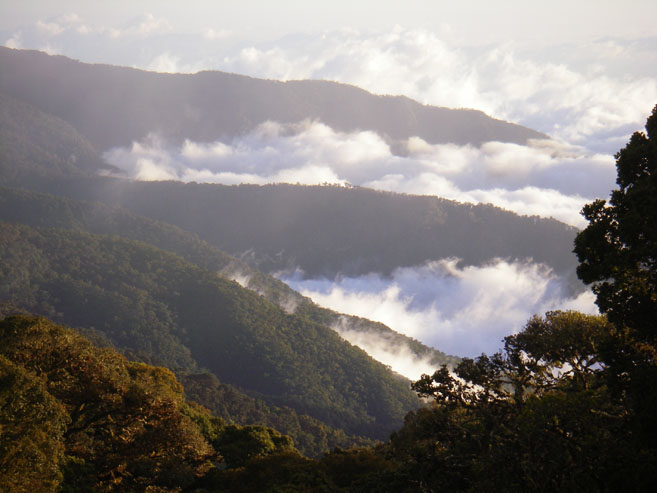 View from Paso los Indios View from Paso los Indios |
After arriving in San Gerardo de Rivas late at night, the town from which our expedition would depart, packing till until even later at night, worrying about forgetting my spoon or how many pairs of sock I packed until sleep came upon me, and waking very early, I found myself in our guide’s home. As we consumed the classic Costa Rican breakfast, actually the classic Costa Rican meal, of rice and beans, we met our guide, Ruldolfo. This introduction lasted only a few seconds, and while this man’s experience of the mountain remained evident, his quiet and reserved demeanor left my tired, coffee-craving mind wondering what lay ahead. |
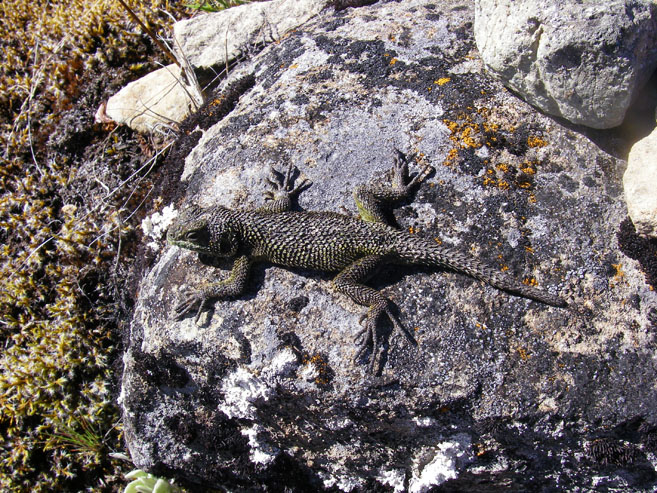 Lizard below Chirripo Lizard below Chirripo |
After finishing those spectacular rice and beans, given they don’t have much variety but are pretty exceptionally tasty in almost every other respect, our trip casually commenced. As we walked out of Rudolfo’s house and up a road, his 12-year-old son rode ahead on horseback carrying food and other odds and ends. We meandered up the valley, stopping when a curious dog attempted to befriend a terrified porcupine. Both parties left the confrontation without physical injury. We continued on, hiking a trail that moved through forests and meadows. The peculiar feeling of trance that happens when you breathe too much fresh air, see too many mountain slopes, and feel the slight soreness associated with walking began to set in. We arrived at the first hut where we would spend the first night at about 2:30 in the afternoon. Propped on a flat spot in a very steep and dramatic cloud forest, it provided an amazing spot to spend the afternoon. Enthralled with our surroundings we spent the afternoon and evening exchanging stories and anecdotes while gazing down the green and steep valley we just walked up, as it spilled into the ridges and plains of the horizon. This laziness continued well into the evening, and we eventually found our way to sleep in the snug hut. |
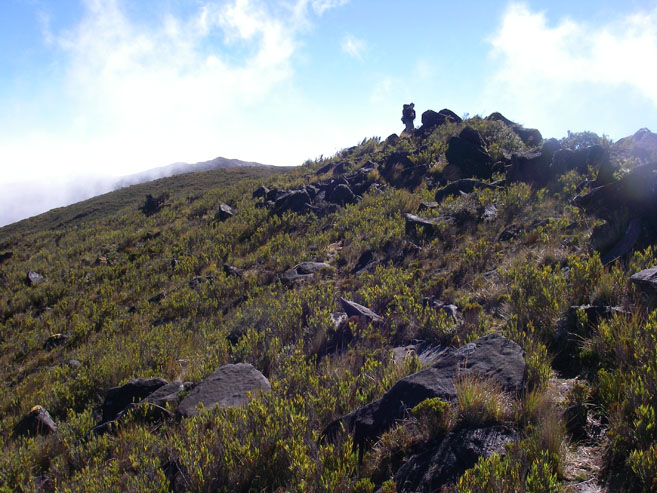 Pararro on the continentaldivide Pararro on the continentaldivide
|
The next morning we woke up early, 4AM early. After managing to leave our sleepy, delirious states behind, we started hiking just as light seeped through the clouds. The first part of the hike required us to climb two miles, through rain forest, up to the continental divide that we would walk along until we reached the summit of Chirripo. The second part required walking along the ridge to a second hut. We glided up the first two miles, climbing quickly and easily. The most important thing I did during this section of our trip was to give myself a very false sense of confidence and lead myself to belief that I would not sweat the rest of the trip. If these two miles taught me this, then the next two would force me to swallow a bitter pill and humble myself quite a bit. As we got to the ridge, I abruptly got introduced to “paramo slogging,” wind, wet, and other difficulties faced when traveling through an environment Mother Nature constructed without me in mind. During the next four hours or so, events became squashed and combined into tiring leaps across puddles and suffering the cold, but eventually a more reasonable trail emerged and our exhausted bodies found a “hut:” more appropriately a “hut in progress” as it still lacked some walls. |
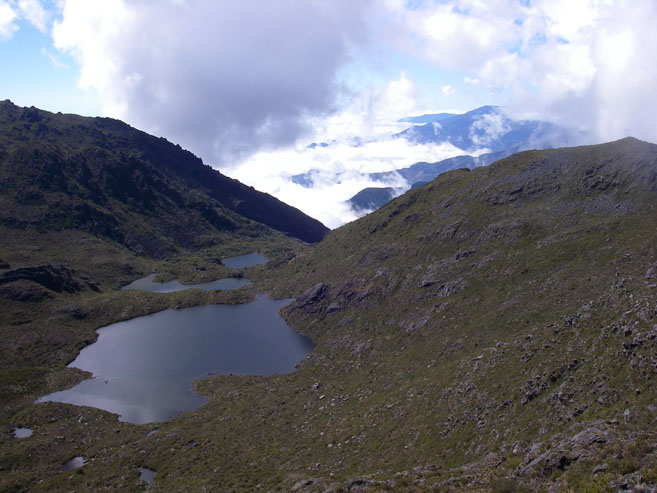 Paternoster lakes in glacial trough Paternoster lakes in glacial trough |
After soothing amounts of sleep, soup and various other comforts that night, we started our next day, which consisted traversing a ridge, crossing Cerro Uran and two more summits on the way to Cerro Chirripo, then descending a glacial trough to a lodge, where we would spend the final night. This day again began at an hour that I usually refer to as night, and we soon were on our way. The trail once again began easy, but the route quickly turned into a rock-hopping, steep extravaganza. Mid-morning, we climbed our first summit, Cerro Uran. We took a break, rewarded ourselves with snacks and sweets, signed the register, and took a look around; Chirripo, a glacial horn, looked a very long way off as it cropped out from the other valleys and mountains. After this stop, we hesitantly continued; walking along the arête, I notice that the trail took even more turns and passed over yet more rocks, so my pace slowed. |
About the time my pace reached an all time low, I looked behind me to see a fellow member of the trip coming closer; I then looked forward to see a steep slope covered in loose rocks with Chirripo’s summit at the top. I was very close. After waiting for this member to catch up, we began the scramble to the summit. A sharp pain accompanied every step, and climbing over boulders became even more excruciating. Soon, a small area of solid level ground to the place of the steep, loose, tittering boulders that I had just climbed; it slowly dawned on me that I had made it to the summit. After some congratulations and a few hugs, I sat down and looked at the area around me. I could see valleys, lakes, and ridges in every direction; they made a sort of web that I happened to be at the center of. I could trace one ridge and see the route that I had come from; I could see the town that I started from. Slowly other members of our group trickled up; we ate, talked, signed the register, looked around some more, and took some pictures. As our departure time approached, I found myself packing up the remains of my cookies, and taking one last look around. Unlike the route up, the route down was on an actual trail, which seemed like a freeway in comparison to the previous “trails” we took to get here. I mostly walked by myself, looking around, in a daze of sorts. Soon the lodge came into view, and I managed to get my limp and exhausted body to a room. We rested for a couple hours then ate some dinner, played some cards, and talked about the day. Everything seemed hazy and in many ways distant. |
 Butterfly on flowers Butterfly on flowers |
The next day we hiked thousands of feet down the remaining miles. Every step hurt and I only thought about getting down. As I approached the trailhead I became impatient, several times I thought I saw the end, only to be devastated to find out that I needed to keep walking. Finally, somehow, the end came and I found myself at a table in a nearby house eating copious amounts of rice, beans, fruits and vegetables, drinking water and a sweet orange-flavored drink. After this meal, we went back to the lodge from which we started; I went to bed and spent the rest of the afternoon sleeping, reading, and staring out my window. The trip left me in a somewhat surreal state; I had passed through numerous extremely diverse environments, and arrived at the top of a high mountain. Yet, the process of going through this trip seemed very simple, I had simply walked and slept; this did not seem to reflect the depth of my feelings and the exceptional wilderness experience. Most of all I found the trek to be humbling, not only did it turn out to be hard challenging physically, but our travel through such extraordinary landscapes left me with a calmer and more thoughtful prospective on the world. |
 Red moss in the paramo
Red moss in the paramo  View from Paso los Indios
View from Paso los Indios  Lizard below Chirripo
Lizard below Chirripo  Pararro on the continentaldivide
Pararro on the continentaldivide  Paternoster lakes in glacial trough
Paternoster lakes in glacial trough  Butterfly on flowers
Butterfly on flowers